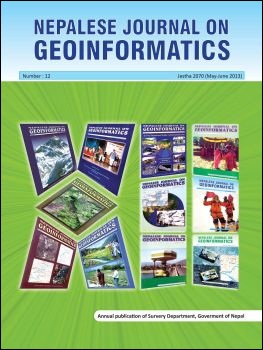Consolidation of Stakeholders' Initiatives to Mitigate Adverse Impacts of Climate Change in Nepalese Context
DOI:
https://doi.org/10.3126/njg.v12i0.9067Keywords:
Green House Gases (GHG), Climate Change, MoLRM, Land Policy, Land Use PolicyAbstract
Although Nepal contributes very low emissions of Greenhouse Gases (GHGs) compared to the developed nations, it is the fourth most vulnerable country in the world due to the effects of climate change. These effects have already lead to more natural disasters, loss of biodiversity, increase in mountain snow melt, uncertainty in precipitation, shortage of food, water and energy etc. resulting in devastating impacts on the life of people living in both mountain and plain areas. Climate change therefore is the vital issue in the country. Understanding the potential impacts of climate change, Government of Nepal since last two decades has taken significant initiatives in response to the effects of climate change including the participations in international conventions, the approval of Climate Change National Policy 2067 (2010), and establishment of a high level Climate Change Council (CCC) under the chairmanship of the Rt. Hon'ble Prime Minister of Nepal. In addition, The Ministry of Environment, Science and Technology (MoEST), being the National Designated Authority (DNA) in Nepal for United Nation Framework Convention on Climate Change (UNFCCC), has executed several programmes and projects related to mitigation and adaptation of climate change effects including Clean Development Mechanism (CDM) projects and National Adaptation Programme of Action (NAPA). International Nongovernmental Organizations such as UNFCCC, DANIDA, DFID, UNEP, UNDP, UN-HABITAT, World Bank, Food and Agricultural Organization (FAO), Asian Development Bank (ADB) etc. as well have carried out numerous climate change projects and activities in Nepal in conjunction with various government agencies.
Studies have revealed that the major sources of GHGs are from the burning of fossil fuel (75%), land use changes (20%), and other sources (5%). It has also been postulated that the effects of climate change can be significantly reduced through the implementation of land use policy and activities. Ministry of Land Reform and Management (MoLRM), Government of Nepal (GoN) is the central agency in Nepal dealing with the formulation and implementation of land related policies and activities in the country. MoLRM has commenced to formulate the National Land Policy and has planned to complete it at the end of fiscal year 069/70. This policy will definitely assist in mitigating the effects of climate change in the country. Another essential policy for the mitigation of the impacts of climate change in the country is National Land Use Policy which was prepared by MoLRM and has been approved by GoN in 2012, but it is yet to be implemented. One of the important policies that it has focussed on for the mitigation of climate change effects is to increase the present forest coverage to 40% of the total area of the country while protecting the government land by forestation and plantation programmes on degraded lands.
Nepalese Journal on Geoinformatics -12, 2070 (2013AD): 1-9




